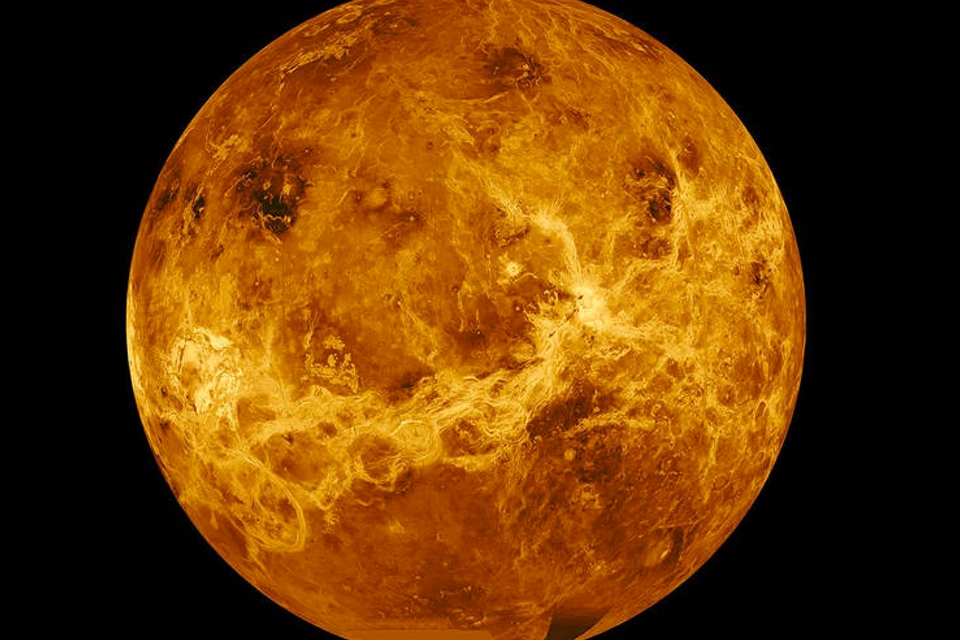The instruments on board the probe are simply not intended or made for it.
Tomorrow morning the time has come. Then BepiColombo makes a first flight past Venus. The probe – on its way to Mercury – will pass Venus at a distance of about 10,720 kilometers. It is mainly a logistical operation; passing Venus at a short distance changes the speed and course of the probe under the influence of Venus’s gravitational field. And so the probe is slowly but surely – it will eventually need several of these so-called ‘gravitational pendulums’ – to be on course to its final destination: Mercury.
Venus
Although the probe is designed to reveal Mercury’s myriad secrets, many are still looking with increased interest at the planet that will approach BepiColombo twice along the way: Venus. Because after it became known last month in the atmosphere of Venus possible traces of life have been discovered – in the form of the gas phosphine – the planet has come to be seen in a completely different light. Where Venus was first seen as the red-hot and inhospitable sister of the earth, the impression has now been given that life may still be possible a little higher in the atmosphere. And the fact that a space probe flies by at a short distance just a month later seems like a gift. Could this probe – equipped with various instruments designed to sift out Mercury’s atmosphere – be able to clarify the existence and origin of phosphine?
Johannes Benkhoff, scientist at BepiColombo, has to disappoint us. “Most likely not. Our instruments are designed to operate on Mercury (…) and they are not sensitive enough to detect this small amount of phosphine. ”
Research
But that certainly does not mean that researchers are leaning back during the fly-by of Venus. Various instruments on board BepiColombo are activated during the razor flight and used to learn more about Venus. “We will observe Venus’ atmosphere with the spectrometers MERTIS and PHEBUS,” Benkhoff says Scientias.nl. “MERTIS will study the day side of Venus (the side lit by the sun, ed.) Almost continuously during the 55 hours prior to the fly-by, focusing specifically on the middle part of Venus’ atmosphere and cloud cover (…). contribute to the research of Venus’ radiation balance (how much solar radiation enters the atmosphere and how much radiation is emitted again, ed.), the structure of the atmosphere, the chemical processes in the cloud cover and the influence that large atmospheric waves have on the weather patterns. ” Meanwhile, PHEBUS is deployed during the flyby to investigate the atmosphere on the night side of Venus. Among other things, the instrument should provide insight into the structure of the atmosphere at an altitude of 80 to 200 kilometers.
Combined observations
But not only BepiColombo pointed various instruments at Venus during the flyby. At the same time observations are also being made by Akatsuki – a Japanese probe orbiting Venus – and the satellite Hisaki. It is expected to result in a much more complete picture of Venus’ atmosphere. And especially of the ionosphere: the top layer of Venus’ atmosphere in which particles are ionized by radiation from the sun.
Two shaving flights
And so tomorrow’s flyby can still yield a lot of new information. Certainly in combination with the second flyby, which is scheduled for August 10, 2021, where the probe will once again aim various instruments at Venus. “During the second flyby, the probe will approach the planet much closer: up to about 552 kilometers,” says Benkhoff. “The job is also slightly different.” But even during this second flyby, it is unlikely that BepiColombo can shed more light on the potential traces of life in Venus’ atmosphere.
Here you can see in red the course of BepiColombo during the first flight and in blue the course during the second flight. Image: Markus Fraenz / MPI / Goettingen.
–
And so, for now, we keep eagerly awaiting what BepiColombo is really built for; revealing Mercury’s greatest secrets. We still have to be patient for that; the probe will not orbit the innermost planet of our solar system until 2025. But it is worth the wait. “Mercury is a mysterious planet,” said Benkhoff. “NASA’s MESSENGER (to date the only space probe to have a close look at Mercury, ed.) Revealed pits on Mercury that may have been formed by processes that are still going on today. It would be a great result if we soon see that these pits have changed since MESSENGER last saw them ten years ago. But studying processes in the exosphere and the interaction between the surface and the solar wind can also lead to new results. ” And so there is much more to research. “Ice in permanently shaded craters, the planetary magnetic field, the structure of the interior of the planet: these are just a few of the dozens of issues we want to know more about.”
POPULAR ON SCIENTIAS.NL
Keep amazed ✨
Receive the most beautiful space photos and interesting popular science articles every Friday. Get the free Scientias Magazine together with 50,000 others.
–

:quality(80)/cdn-kiosk-api.telegraaf.nl/16b0d884-0e1d-11eb-8517-02d2fb1aa1d7.jpg)
:quality(80)/cdn-kiosk-api.telegraaf.nl/710b2656-0df3-11eb-9caf-02d1dbdc35d1.jpg)